As an e-commerce website owner, I understand the thrill of driving traffic to your online store. Whether it’s through content marketing, paid ads, or affiliate partnerships, each visitor represents a potential sale. But when those visitors leave your website without making a purchase, it can feel like a missed opportunity. That’s why I’m here to emphasize the crucial importance of optimizing your ecommerce conversion rates.
These conversion rates, along with the personalization that complements them, are your most powerful tools to measure your return on investment (ROI). By using conversion rate optimization to enhance your website, you can significantly boost your ROI.
Understanding the Power of Ecommerce Conversion Rates
Let’s dive right in and explore why optimizing your ecommerce conversion rate is vital for your online business.
What is Ecommerce Conversion Rate and Why Should You Care?
Ecommerce conversion rate is the percentage of visitors to your website who take the desired action, such as making a purchase or signing up for a newsletter. An improved conversion rate means more sales and revenue for your business. It can be a game-changer for your profitability.
How to Calculate Your Conversion Rate?
(Number of Conversions / Total Visitors) x 100 = Conversion Rate
Let’s understand this further – If your online store is getting 10,000 visitors and lets say 300 visitors either purchase a product or sign-up for your newsletter or added a product to their shopping cart for a set period, that means your store’s conversion rate is 3%.
So what is a good e-commerce conversion rate?
As per the latest global survey by Adobe – On average, ecommerce websites should expect to see a conversion rate of 1% to 4%. Global ecommerce website conversion rate: 2.58%
Your average ecommerce conversion rate will differ wildly depending on your industry. As of Q4 2022, these are the average conversion rates for the top six ecommerce verticals:
- Fashion and apparel: 2.7%
- Health and beauty: 3.3%
- Entertainment: 2.5%
- Household goods: 2.1%
- Electronics: 1.9%
- Food and beverage: 4.6%
Food and beverage and health and beauty were some of the top-converting verticals in ecommerce in 2022. This might be because these products tend to cost less than, say, household goods or electronics, so the barrier to entry is lower for shoppers.
Improving Your Ecommerce Website Conversion Rates – 5 Practical Tips
To boost your conversion rates, you need to optimize your ecommerce website systematically. Here are the 5 practical tips anyone can implement :
1. Simple Layout but Visually Appealing Optimised for Speed

If your customers can’t find what they are looking for almost immediately, they will leave your website. Take some time to design and structure your website correctly. Focus on the most important offers or products and make sure they are the first thing your visitors see when they come to your website.
Using simple layout with visually appealing images is the key to increasing website conversion rates.
In today’s hyper-fast world, online brands only have less than 5 seconds to capture a shoppers’ attention before 50% or more begin leaving the site. If you want a strong conversion rate, make sure your entire website consistently loads quickly.
Pro Tip:
Make sure your website is optimised for mobile devices. Many shoppers use their smartphones to browse and buy. Ensure your website is mobile-responsive and offers a smooth shopping experience. You can read – Why Mobile Optimization is Crucial for Your Website?
2. Showcase Social Proof
The best thing you can do to improve your ecommerce conversion rates are showing testimonials. There is nothing more powerful than seeing the proof that the product has worked for someone else. In fact according to a study conducted by Nielsen, 84% of consumers trust recommendations from friends, family members, and peers over any other type of marketing or advertising content.
Some of the most commonly used testimonials format that have guaranteed higher conversion rates –
- Expert Reviews
- Reviews by existing customers who recently purchased your product
- Reviews by Influencers in your industry
- If you’re selling on Amazon or other Marketplaces – then sharing those reviews on your website.
Remember the first time shopper is in research mode when they come to your website. When they see a review on the product page and see that it has been validated by someone else – it is bound to increase confidence in your product thus increasing your chance of conversion.
3. Adding Trust Signals
Trust signals are elements of a site that make customers feel reassured about their shopping experience. They indicate to the customer that the site is a legitimate business and reduce perceived risk of making a purchase. Here are some clear trust signals, to improve ecommerce conversion rate, that every website should have –
- Security Badges such as SSL certificates, Payment Protection, etc can have significant impact.
- Clear and Transparent Shipping, Cancellation and Returns Policy
- Customer reviews across the website
- Display Contact Information
- Detailed and Clear Product Description
- Include Social Media Links
4. Streamlined Checkout Process
A complicated checkout process is a conversion killer. Keep it simple, with as few steps as possible, and consider offering guest checkout options.
If your store checkout process is too long or there are multiple steps involved in adding a product to cart, the chances of drop-off increase tremendously. There are industry standards for checkouts on most hosted ecommerce platforms like WooCommerce or Shopify, but you may still need to tweak the process based on your customers.
Pro Tip:
Pay attention to abandoned carts – if you consistently deal with abandoned carts, then abandoned cart recovery emails can help increase your ecommerce conversion rates. Most of the ecommerce platforms have a built-in mechanism for sending abandoned cart recovery emails on your behalf.
Offer a 10% discount to those customers or add them to an email automation process to nurture them to a buy. There is no doubt that abandoned cart recovery can help ecommerce stores increase their revenue.
5. Focus on Product Pages
For an ecommerce website product pages are the most important aspect for conversion. You need to make sure that your product pages are thoroughly optimised and nudge the visitor to make a purchase. Here are the most fundamental elements every product page should have –
- Clear and concise product descriptions. A short description about what the product does and its benefits and a long description about the product specifications and uses.
- Create a sense of urgency by offering discounts and limited time offers.
- Add ratings and reviews as already mentioned above.
- Cross-sell or up-sell other products by bundling them together with other complimentary products.
- Add a Direct Buy button on all product pages and offer Free Shipping.
- Include a guarantee or easy returns policy.
- Clearly state your unique selling proposition.
Is Your Ecommerce Website Optimised for Conversion?
A professional website audit can help identify areas for improvement and prioritize changes to maximize your website’s performance.
Some more tips that can help boost ecommerce conversion rates
While we have covered the 5 most practical tips you can implement straight away to improve your ecommerce conversion rates, here are some more tips that can help boost your revenue. But many of these require expertise –
- Product Recommendations – Personalisation is a key driver of high conversion rates. Use algorithms to suggest products based on a user’s past browsing and purchasing behavior. This can significantly boost cross-selling and upselling.
- Email Marketing – Segment your email lists and send personalized recommendations and promotions to different groups of subscribers. Email marketing, when done effectively, has the best ROI compared to any outbound marketing channels.
- A/B Testing – A/B testing is a powerful tool that lets you experiment with changes to your website and determine which version performs better in terms of conversions. But for this to be implemented, you will need access to third party analytics tools and / or expert help.
- Filters and Sorting on Category Pages – Convenience is key when online shopping is concerned. One of the most under-rated feature is filtering and sorting in category pages. They are are crucial in helping your customers navigate and drill down to the right products.
- Landing Pages – When running paid ads or social media campaigns do not redirect visitor directly to a product page instead use landing pages. Landing pages are the best place to improve your conversion rates and give you a clear idea of what’s working.
At Think Logic , we have expertise in designing optimised landing pages for ecommerce websites.
Ecommerce Website Optimisation Service
Experts in website optimization, Think Logic team can implement the changes needed to increase your conversion rates and drive higher ROI.
The Final Word – Find your Conversion Opportunity and Fix it
In the world of e-commerce, every visitor who leaves without making a purchase is indeed a missed opportunity. However, by focusing on optimising your conversion rates and personalising your website, you can turn these missed opportunities into increased sales and profitability.
If you’re looking to embark on a similar journey, consider partnering with professionals who can conduct a website audit and implement optimization services. These can be your keys to unlocking the full potential of your e-commerce business and achieving a higher ROI.




